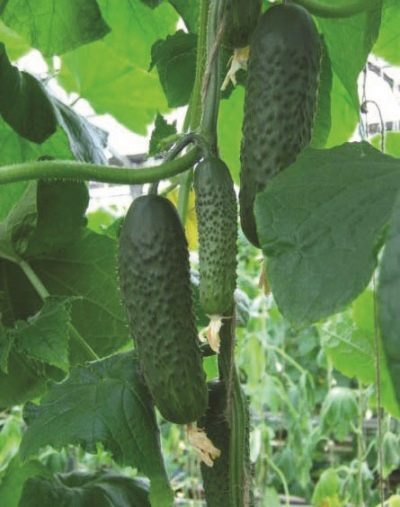
- Authors: Motov V.M., Biryukova N.K., Erdyakova V.A.
- Year of approval: 2007
- Growth type: indeterminate
- Branching: the average
- Fruit weight, g: 135
- Fruit length, cm: 12-14
- Fruit color: green with short stripes
- Cucumber Mosaic Virus Resistance: stable
- Ripening terms: early
- Fruit shape: cylindrical
The hybrid variety Vyatsky was included in the State Register in 2007. Its advantages include high yields, a long fruiting period and the ability to develop in not the most favorable conditions.
Description of the variety
This variety is characterized by a female flowering type. Parthenocarpic, it reproduces without the attraction of insects. The variety has good immunity and is able to withstand diseases such as powdery mildew and mosaic. Growing cucumbers is equally successful both in the open field and under a temporary film cover.
Characteristics of the appearance of plants and zelents
Medium-sized bushes of the Vyatsky variety form long lashes, in the nodes of which 1-2 bundle-shaped ovaries appear. The length of the main stem of the plant, 200 centimeters, is reached 3 weeks after planting in its permanent habitat. Small heart-shaped leaves are sometimes covered with villi. The stem thickness reaches 1.5 centimeters, which increases its stability even in the case of a large number of fruits. The length of the elongated fruits of the hybrid ranges from 12 to 14 centimeters, and its diameter reaches 3.5-4 centimeters. The weight of a cucumber is up to 135 grams. Zelentsy have a bright green tint and are covered with tubercles closely spaced to each other.
Purpose and taste of fruits
The delicate pulp of the fruit is devoid of voids and even a hint of bitterness. Moreover, even the peel of the "tired" fruit will not taste bitter. Cucumbers have an excellent sweetish taste and pleasant aroma. Vegetables are actively used for making salads, pickling and pickling. Even after heat treatment, the pulp remains firm and crispy. Fruits of the Vyatsky variety are well transported and demonstrate decent keeping quality, even maintaining a crunch during long-term storage.
Maturation
The lettuce variety Vyatsky belongs to the early maturing, since the harvest appears already 5-6 weeks after the emergence of seedlings or a month after planting on open ground. The last batches of cucumbers are removed from the bushes at the end of October.
Yield
The yield of the hybrid is very high: the gardener manages to collect an average of 12.5-14.5 kilograms of cucumbers from each square meter of the garden per season. As for one bush, it can produce about 7-7.5 kilograms of vegetables. Conveniently, a ripe crop can be removed every 3-5 days. Interestingly, the Vyatsky variety has the same yield both outdoors and indoors.
Growing and care
Sowing seeds on the ground is carried out from the second half of May, when the soil is already warming up to +15 degrees, which means that the material will not freeze. For cucumbers, a well-lit area is selected, protected from the winds. The soil is prepared in the previous autumn by digging, removing weeds and adding fertilizers: manure and wood ash. Immediately before sowing, superphosphate and potassium-phosphorus compounds are also introduced. The seeds are placed in holes 3 centimeters deep and well watered with warm water.
If the gardener chooses the seedling method, then the seeds are planted in peat pots or individual containers, also with a depression of 3 centimeters. Plants are transplanted to their permanent habitat when they reach 20 centimeters in height and form 5 full-fledged leaves. They are arranged in such a way that no more than 3 copies are present on each square meter.
For cucumbers of the Vyatsky variety, regular watering is required, carried out either in the early morning or late in the evening. It is allowed to use for the procedure only settled water, warmed up to +25 degrees. Usually watering is carried out every 2-3 days, and for an adult plant, almost 6 liters of liquid are required. If the temperature exceeds +28 degrees, additional sprinkling is carried out for cucumbers. At the stage of the appearance of flowers, watering can be accompanied by top dressing, diluting 1 liter of manure or 10 grams of urea in a bucket of water.
Since the hybrid has a rather weak root system, the crop should not be weeded or replanted. Weeds are always cut with a pruning shear at ground level. The first feeding is arranged as soon as 5-7 leaves appear on the cucumbers - these should be nitrogen-containing substances. During flowering, the culture will need a mixture of superphosphate and two types of nitrate: potash and ammonium. The third feeding is carried out at the fruiting stage with the use of potassium-phosphorus complexes. In addition, at any time the culture can be "pleased" with organic matter - a pack of yeast dissolved in a bucket of water and infused for 3 days.
Hilling for cucumbers is not required, since the roots of the plant are located close to the surface and can be damaged during the procedure. However, gardeners are advised to loosen the area with a pitchfork once a week, which will destroy the earth crust and provide oxygen to the roots.

In order to collect strong, tasty and beautiful cucumbers on your site, you need to make top dressing. Lack of nutrients can negatively affect the appearance of the plant and significantly reduce the yield. Fertilize cucumbers with organic fertilizers in combination with mineral fertilizers. With the right balance of these components and adherence to the fertilizing schedule, the cucumber yield will be maximum.

Despite their popularity, cucumbers are often attacked by diseases and pests. From them, cucumber plantings often die before the start of fruiting. In order to prevent this from happening, it is necessary to try to prevent ailments or get rid of them at the very beginning, having studied in detail their causes of occurrence, signs and methods of treatment.





























































































